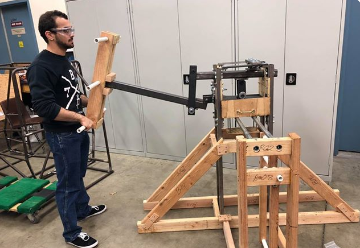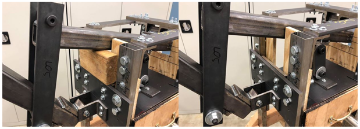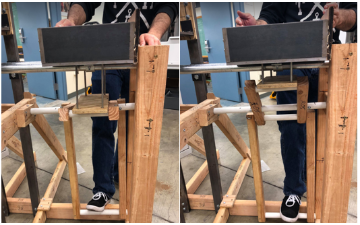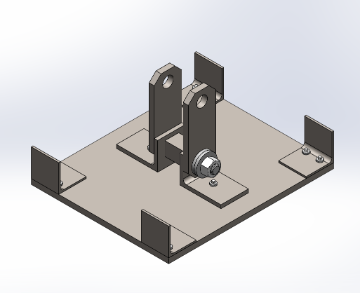Resilient Design is an important concept that bridges the gap between the engineering and user end in engineering design. “Resilience” encapsulates the value and robustness of design solutions. Not only does it pertain to technical aspects such as weather resistance, energy efficiency, and safety, but it also demands engineered products to satisfy dynamic consumer needs, wants, and concerns on design elements such as “flexibility”, “ruggedness”, and “simplicity”[2]. Satisfying these dimensions in resilient design is seen less as a focus on engineering optimization, but rather, a focus on user-centricity in engineering design solutions.
Principles of Resilient Design : Trade-offs in the Frugal Clay Press for Nicaragua Senior Design Project
Whether or not it is apparent from a more technical perspective in design, engineers are constantly looking to incorporate elements of resilience in design throughout the design process. As a mechanical engineering student who pursued a project with the Frugal Innovation Hub, I worked on a design project that demanded extensive analysis of cost, stress, and building materials to produce a functional human powered clay press for clay workers in rural Nicaragua. Emphasizing the cheapness and accessibility of the materials that composed our project greatly influenced the changes we made to our design in the iterative phase. Equally as important, however, were the considerations we made regarding the “user-centricity” of our design subsystems, as we designed our device to require the least amount of force and range of motion from the user for the most amount of clay compression.
The Resilient Design Institute defines ten principles of resilient design that help translate user requirements to quantifiable engineering specifications that need to combine in the iterative design process [2]. Altogether, these design principles emphasize the need for designers to evaluate their design and make Utilitarian choices that seek to maximize the durability, quality, and performance of the design while minimizing the potential for the design solution to be dangerous, temporary, expensive, or otherwise inappropriate for the customer or target community.
As you and your team continue to revisit previous parts of the design process in the iterative phase, applying Resilient Design Principles in your considerations can improve the creativity and quality of the design decisions you make. Some of these principles of resilience influenced various design decisions in my own project.
The Resilient Design Principles
1 “Resilience transcends scales. Strategies to address resilience apply at scales of individual buildings, communities, and larger regional and ecosystem scales; they also apply at different time scales—from immediate to long-term.” [2]
Utilitarianism in design is concerned with the scale or scope of the project. The bigger the project is, the larger the potential costs and benefits are. Resilience in design asks engineers to consider this, and look for ways that these costs will not compromise the safety or effectiveness of the design solution on larger scales.
Personal Link:
At the beginning of our design project, we set out to design a frugal clay press that could be built cheaply and used anywhere in the world. Our project idea came from a professor who worked on an Engineers Without Borders project, where SCU engineers travelled to Rwanda and worked with a community that manufactured clay tiles. Because clay working is a strenuous and time consuming by hand in any part of the world, we were challenged to design an extrusion or press system that could produce clay tiles of varying thicknesses. The machine would also be able to handle the production of bricks, which could diversify the products of clay working communities around the world and allow for their financial growth.
While the concept of a frugal clay machine for rural communities seemed to promise application on a large scale, our research on existing clay extrusion and press systems concluded that our senior design project had to be a simple mechanical press. The largest factor in this decision was that effective extrusion systems require a substantial amount of power that cannot be produced by a human operator. Clay extrusion systems specifically required electrical input, which would have not allowed our press to be affordable or accessible in rural communities. We also did not know initially that clay is not a monolithic building material. Our work with the Department of Civil Engineering taught us that clay is not the same in every part of the world-- and for each clay, the mechanical properties were dependent on how much water was mixed with the clay. Even if we had designed a press that could adequately compress a single type of clay, the same press would not necessarily be an effective nor robust solution in areas of different climates and native clay types.
To better move towards producing a more resilient product, our team narrowed our design to be a mechanical clay brick press for a specific community in Nicaragua. By choosing a single customer and working with them to design our press, we adapted our design to have characteristics that would allow the device to be used by the community for a long period of time. Compromising the variability in the type of clay building materials our design could handle and functionality in various parts of the world was necessary for our press to be affordable, robust, and resilient in the community we aimed to serve.
2 “Resilient systems provide for basic human needs. These include potable water, sanitation, energy, livable conditions (temperature and humidity), lighting, safe air, occupant health, and food; these should be equitably distributed.” [2].
Utilitarian considerations also seek to maximize the accessibility of goods for basic human needs, while minimizing negative environmental impacts, lead time, and cost. A large part of the Utilitarian calculus is determining how resources can be “equitably distributed”-- without leading to significant costs that compromise the success of a project.
Personal Link:
The health of the operators of the device were part of the considerations we had in redesigning the lever arm subsystem of our clay press. When we initially connected with our customer in Nicaragua, the methods of clay brick molding and forming were all rather physically strenuous by-hand processes. To mix the clay, workers would have to use a considerable amount of freshwater to get the soil to a wetness that would allow them to stomp on it with their bare feet. The clay would then be put into a mound on the ground where clay workers would have to squat to fill wooden clay molds to form four bricks at a time.

Figure 1: Operation of the Lever Arm subsystem of the Frugal Clay Press. Note that there is a three tiered handle that allows for the user to achieve maximum mechanical advantage throughout the stroke without having to reach too high or too low during compression.
Although this process seemed to be working for them, we realized that clay workers have to use a considerable amount of physical effort in a very uncomfortable range of motion when forming clay bricks. Because of this our team designed all operations of the Frugal Clay Press to be completed from standing position. The input lever of the device was connected to a compound lever system, which effectively reduced the amount of input force needed from the user to compress the clay. Moreover, we implemented a three tiered lever arm “ladder” handle that made it so that a user would be able to achieve maximum mechanical advantage throughout the stroke of the lever without having to reach too high or too low.
4 “Simple, passive, and flexible systems are more resilient. Passive or manual-override systems are more resilient than complex solutions that can break down and require ongoing maintenance. Flexible solutions are able to adapt to changing conditions both in the short- and long-term.” [2].
Designing for simple, passive, and flexible systems may be useful in reducing the cost of materials and overall design work. That being said, extra care has to be taken to ensure that implementing these simple systems does not decrease the safety or the effectiveness of the design solution.
Personal Link:
Although my design project was to produce a manual clay press, which did require user interaction and dynamic subsystems, our design team sought to implement several passive solutions that reduced the cost of the device while still achieving necessary functionalities. One of these was the implementation of a wooden block stop to the Lever Arm subsystem. During testing, it became a concern of our faculty advisor that the input lever did not have a latch or stop implemented on it. If a user were to back away suddenly, the entire Lever Arm would fall and could possibly hurt someone. Our team weighed our options and realized that while a latch design would be useful, it would have also increased the time necessary to finalize our design and increase the cost of materials of the prototype. We instead chose to attach a simple wooden block stop to a string that could be inserted in between the Lever Arm and Base Fixture of the device when not in use. This passive solution was quickly and cheaply implemented, enabling our team to more safely conduct testing before the Senior Design Conference.

Figure 2: The simple wooden block stop implemented to keep the input lever from falling or trapping extremities when not in use.
6 “Locally available, renewable, or reclaimed resources are more resilient. Reliance on abundant local resources, such as solar energy, annually replenished groundwater, and local food provides greater resilience than dependence on nonrenewable resources or resources from far away.” [2].
Seeking to implement materials that can be found locally to the community you are designing for is part of minimizing costs and increasing the manufacturability of your design solution. Considerations should be made, however, in deciding if imported or locally accessible materials achieve the best results in your design.
Personal Link:
A major consideration that my team kept in the design process was the availability of the building materials we used in the design in Nicaragua. One central goal of our Voice of Customer assessments and travel to Nicaragua in March of 2018 was to confirm that hot rolled steel, coarse-threaded english system fasteners and bolts, and construction wood were locally accessible by the community in Ciudad Darío. During my visit, I took a day to travel to small towns around a ten mile radius of Ciudad Darío and visited local hardware stores and machine shops. I managed to talk with the owners of these shops and, one by one, made sure that the materials that we used in our prototype could indeed be found in Nicaragua.

Figure 3: Available hardware and machinery in Sébaco, ten miles away from the city of Ciudad Darío.
What we found was that, with the exception of the bulkier pivot bolts in our assembly, all of our prototype materials could be purchased or fabricated easily by local machinists. What was also significant was that our visit determined that we could also design for welding. Our prototype relied on fasteners for a majority of the subsystem mates because we designed with the hope that our community could assemble the prototype without needing a welder. Upon visiting Nicaragua, we modified our design to be assembled either through welding or fasteners-- thus increasing the flexibility of our design to meet our customer’s needs.
9 “Social equity and community contribute to resilience. Strong, culturally diverse communities in which people know, respect, and care for each other will fare better during times of stress or disturbance. Social aspects of resilience can be as important as physical responses.” [2].
Social benefits and harms are also part of Utilitarian considerations. While you may try to increase the effectiveness and safety of the design, it is also wise to seek to minimize the potential of the design solution to contribute to social inequality, violence, criminal activity, or unemployment.
Personal Link:

Figure 4: Use of the foot pedal for elevating the clay brick out of the Compression Chamber.
A large focus of our customer in Nicaragua was that the device would contribute to the culture of collaboration in clay working of the social entrepreneurship. This was reasserted to my colleague and me in our conversations with the clay workers, as a fear of theirs was that the implementation of our press would give their employer reason to not continue to employ them. With this in mind, our team designed the Frugal Clay Press to be operated by two to three individuals. A single individual would be responsible for operating the Lever Arm subsystem, which was used to compress the clay. Another individual would be responsible for sliding the Compression Chamber inside and out of the compression area, as well as loading the chamber with clay for the next cycle. Finally, another individual would be tasked with actuating a foot pedal and raising the elevating base of the chamber, which would extract the compressed brick from the chamber. Designing for user collaboration was useful in not only making the process of operating our device more efficient but in ensuring that all employees could have a part in brick formation processes.
10 “Resilience is not absolute. Recognize that incremental steps can be taken and that total resilience in the face of all situations is not possible. Implement what is feasible in the short term and work to achieve greater resilience in stages.” [2].
Just as it is impossible to eliminate all harms with a project, resilience is not absolute. These “incremental steps” that are taken to move towards resilience in design rely on Utilitarian considerations on how to bolster the benefits of the engineering solution while minimizing the harms or inconveniences that are experienced.
Personal Link:
What was apparent by the time our team completed a standing prototype was that our design was not of the quality nor of the effectiveness expected by our customer and could not be deployed to Nicaragua at the end of the senior design project. This was mainly due to tolerancing errors between major subsystems, which led to mechanical interaction issues that created delays and inconveniences in user operation. Of these issues, however, the most prominent was that the device was not able to consistently achieve level compression. The Compression Plate system, which was attached to the output lever of the Lever Arm subsystem, would sometimes tilt upon its descent and cause the surface of the clay to be compress unevenly.

Figure 5: 3D model of the Compression Plate subsystem. Authored by L. Isaac Marcia.
Our team realized that with the time we had, the most feasible design solution we could implement was the addition of steel angles to act as stabilizers during the descent of the Compression Plate. While they were not perfectly able to stop the tilting of the Compression Plate during compression, the plate stabilizers allowed our team to properly conduct prototype operation tests. These tests were necessary in validating the prototype for the purposes of the senior design thesis.
References:
[2] “The Resilient Design Principles.” Resilient Design Institute, Resilient Design Institute, 3 Oct. 2013, www.resilientdesign.org/the-resilient-design-principles/.
